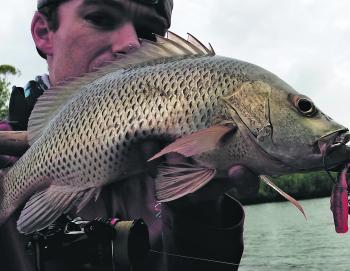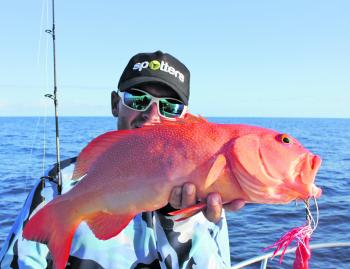The opportunities that March provides can be mind-blowing. Once again, it depends on the weather and how much rain we receive. Last month there hadn’t been much in terms of rainfall except for the odd shower and storm, but March is when we normally see the bulk of our rainfall and boy, do we need it!
So as long as you don’t mind fishing in torrential rainsqualls, searing heat, humidity so thick you can choke on it and mozzies that resemble small birds…you should be in for epic sessions. All tropical fish are hungry and aggressive as the wet season swings into full force.
The Hinchinbrook Channel comes alive and the fish feed up. I have already got the shakes just from thinking about the fish I’m going to get into. Let’s see what Lucinda NQ has to offer this month.
I’ll start off by stating the Channel will fish well, but it is very important to take note of the rainfall or flooding that we may get. If this is the case, then it is necessary to do some kilometres and find cleaner water. If we have had lots of rain, the southern areas of the channel will run very brown and dirty, as the Herbert and Seymour rivers will be pumping out the freshwater. The best bet by far is to navigate up the channel carefully, or launch at Fishers Creek ramp or Cardwell as the water will normally be cleaner and easier to fish.
Barramundi are at the top of the list, and it’s at this time of year that fishing the drains is by far the easiest and most productive way to get among them. Drains are simply a perfect place for fish to sit and wait for food to be pushed down to them. You want to get to your chosen area a few hours after the tide has turned and is running out, the water needs to be just creeping out of the mangrove edges.
The drains are easily visible and are normally only a meter or less across, but when they are working, the water pushing out of them will be darker in colour. It is very important to stay off the area you are going to fish, and as always, make as little noise as possible. Drain areas and flats are normally shallow and noise will travel very easily. Shallow running lures and very lightly weighted soft plastics are the best bet.
It’s hard to beat a slowly retrieved shallow diver worked erratically back to the boat, or a paddle-tail plastic rigged on a 1/6oz jighead slow rolled. You will find mangrove jacks and grunter feeding in the drains as well and both will eat the above presentations.
When the drains are really on fire you will see barra and jacks smack baitfish right before your eyes and trust me, that’s when the heart beats quicker… and when you don’t want to be re-rigging or having a sandwich.
As it’s so hot and humid this time of year, plenty of anglers head out in the later afternoon and fish into the night as it’s more comfortable and a great time to catch fish. Gather some livies and fresh baits and anchor up in the Channel or creeks for a good chance of bringing home some tasty fish for the table. I must add that if we have had some floodwaters, then the possibility of running into floating debris is very high so be cautious.
The summer months are the time to chase big cobia that hang around the inshore islands, wrecks and jetty. Cobia will normally show themselves after a period of time, and in most cases it will be after there have been a few fish caught. They must follow them up looking for a feed or they are just inquisitive and want to check out what’s going on near the surface.
If they do appear, then a quickly thrown plastic should get eaten. Don’t throw the plastic at the fish, cast it in front of them by a few metres – they have awesome eyesight. They should turn on it and eat it, no worries. If this isn’t working and the cobia are fussy, then a live bait put out a few meters under the surface never fails.
The jetty is a good place to chase golden snapper (fingermark) on the smaller tides, and the better times are the evening tide changes, especially when the tide starts to run-in. Get live herring or sardines or even better, live squid, to see you get hooked up to those magnificent fish. They fight hard and have the ability to rip some line off your reel, so don’t go too under-gunned or you will pay.
They live in close to the jetty pylons and they know where their home is when you sink a hook into them. Golden snapper can also be targeted with soft plastics and vibe type lures fished close to bottom structure, baitfish or fish shown on a sounder. Make sure your offering remains close to the bottom and hang on.
I haven’t been doing much out on the reef and the weather has not been kind in the last few months. The few who have got out have done well in the deeper waters for trout and nannygai, both small and large-mouth.
Try to avoid the middle of the day, as it’s too hot and the fishing is at its slowest. The best bite periods are tide changes in the morning, or my favourite, the afternoon and evening.
Reads: 918
You can never get sick of looking at barra.

Jacks are hungry in the heat! Always be ready for a jack strike.

It’s hard to beat bringing trout home for dinner.




